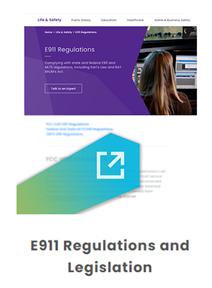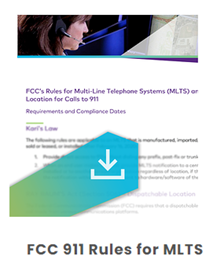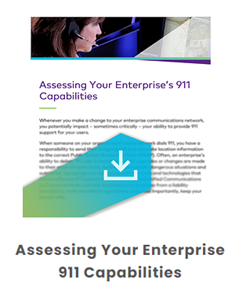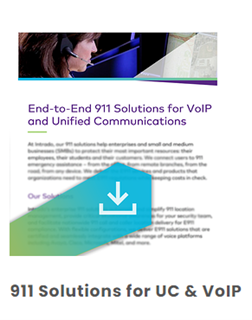Kari's Law & RAY BAUM'S Act
Kari’s Law & RAY BAUM's Act:
What do they mean for YOUR business?
.png?width=692&height=629&name=MicrosoftTeams-image%20(1).png)
The Federal Communications Commission (FCC) regulations require organizations with multi-line telephone systems (MLTS) to have direct access to dial 911 – without unnecessary or redundant steps.
Key Takeaways
Dialing a 9, a prefix, postfix, or trunk access code is no longer status quo, and onsite security or staff must get notified of 911 calls that take place within the workplace – as required by Kari’s Law.
quo, and onsite security or staff must get notified of 911 calls that take place within the workplace – as required by Kari’s Law.
With RAY BAUM’s Act, organizations must provide a dispatchable location which includes: street address, building, floor, suite, or room numbers, when a 911 call is placed – along with a valid callback number.
Assimilating your business into compliance with these new laws and regulations can sound challenging and laborious, but having the right leader to help guide your efforts can make the deadline of February 16, 2020 date less alarming.
The Original Kari
 Kari’s Law was signed into federal law on February 16, 2018, after a tragic emergency situation. Kari Hunt Dunn was killed and her 9-year-old daughter was unable to reach emergency services because she didn’t know to dial “9” to reach outside lines before dialing 911.
Kari’s Law was signed into federal law on February 16, 2018, after a tragic emergency situation. Kari Hunt Dunn was killed and her 9-year-old daughter was unable to reach emergency services because she didn’t know to dial “9” to reach outside lines before dialing 911.
Kari’s Law requires businesses to enable the direct dialing of “911” and directs the FCC to establish necessary 911 calling regulations for the MLTS that are commonly used in buildings such as hotels, hospitals, and most office campuses.
Accurate & Precise Dispatchable Locations
 RAY BAUM’s Act requires that all 911 calls must have a “dispatchable location”, as referred to by the FCC. Dispatchable location means having adequate information for emergency responders to find the exact location of a person who has dialed 911.
RAY BAUM’s Act requires that all 911 calls must have a “dispatchable location”, as referred to by the FCC. Dispatchable location means having adequate information for emergency responders to find the exact location of a person who has dialed 911.
Let’s say there is a critical emergency in your office building, and you’re located in the conference room on the 7th floor. You pick up the phone and dial 911. This is where another federal law called RAY BAUM’s Act, comes into play. The rules and regulations state that campuses that use MLTS are required to be able to pass along location information that would be more precise than a front desk. More specifically, the dispatchable location information would give information like building, floor, room, etc.
Alyssa's Law
Some states have either passed or are in the process of adopting Alyssa’s Law which requires schools to implement silent panic alarms with a direct connection to local law enforcement. The law is currently in place in New Jersey and Florida, with other states and the U.S. Congress sponsoring the legislation.
Alyssa’s Law which requires schools to implement silent panic alarms with a direct connection to local law enforcement. The law is currently in place in New Jersey and Florida, with other states and the U.S. Congress sponsoring the legislation.
Who’s Impacted?
- Companies with multiple office locations, including financial institutions, medical facilities
- School campuses – both public and private, K12 through higher education
When’s the Deadline?
For enterprises with fixed MLTS phones, the change took effect in January 2021; organizations with non-fixed MLTS devices on- and off-premises must comply with these regulatory obligations by January 6, 2022. All requirements apply to MLTS manufactured, imported, offered for first sale or lease, first sold or leased, or installed after February 16, 2020.
Get Help from the Leaders
 Intrado experts have a deep understanding of federal and state-level regulations and compliance requirements. Intrado’s product suite spans the entire 911 continuum, with solutions for enterprises and educational institutions of every type.
Intrado experts have a deep understanding of federal and state-level regulations and compliance requirements. Intrado’s product suite spans the entire 911 continuum, with solutions for enterprises and educational institutions of every type.
Contact us to learn more about E911 compliance, emergency location management, call routing, notifications, and panic buttons, or request an assessment using the form on the right.

